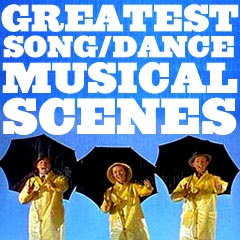
|
|
| R | ||
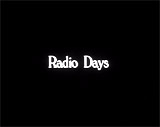
|
Radio Days (1987) Narrated (as Joe), written, and directed by Woody Allen, this comedy-drama looked back on the Era of Radio, and featured many nostalgic 30's and 40's hit standards (such as Glenn Miller's In the Mood and The White Cliffs of Dover, Benny Goodman's Body and Soul and Goodbye, and Guy Lombardo's That Old Feeling) sung and/or danced to by radio personalities. In the opening segment recreating the game show "Guess That Tune" (pictured) hosted by Don Pardo (Himself), three songs were played and identified by a burglar (Paul Herman) during a robbery in progress at the Marty Needleman residence: Dancing in the Dark, Chinatown, My Chinatown, and The Sailor's Hornpipe, and won the jackpot for the family. Radio programs and music were heard by a Jewish-American family living in Rockaway Beach (Queens) New York in the early 40s. In some instances, family members escaped reality while listening:
At the film's end, Diane Keaton (as a Sophisticated Songstress -- a New Year's Singer) also performed Cole Porter's You'd Be So Nice To Come Home To (pictured). |
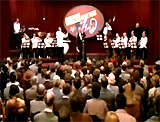  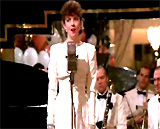
|
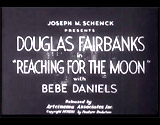
|
Reaching for the Moon (1930) This Edmund Goulding-directed black/white, Depression-Era romantic comedy/farce starred Douglas Fairbanks (as Wall Street tycoon-stockbroker Larry Day) and Bebe Daniels (as Vivien Benton, his love interest - a wealthy socialite and amateur aviatrix). [Note: It was unrelated to Fairbanks' silent film, Reaching for the Moon (1917).] It also featured Bing Crosby in his feature film screen debut as a solo performer. [Note: In the same year, Crosby appeared in The King of Jazz (1930) as a member of the Whiteman Rhythm Boys in a couple of musical skits.] It was initially the first musical showcasing of Irving Berlin songs - but all of his songs were removed except for:
|
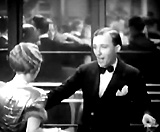 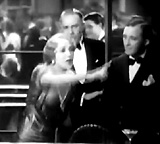
|
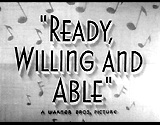
|
Ready, Willing and Able (1937) This Ray Enright-directed Warner Bros' backstage musical was about mistaken identity. US college student Jane Clarke (Ruby Keeler) from Broadfield College, who had aspirations to be in show-business, was hired (mistakenly) for the upcoming Broadway musical comedy show titled 'Fair Lady'. To carry on the ruse, Jane impersonated the famous and popular British stage star - the real Jane Clarke. Its most fantastic production number in the final sequence began with the catchy song Too Marvelous For Words (pictured) (often repeated in the film), written by Richard Whiting with lyrics by Johnny Mercer. Theatrical producer Barry Granville (Ross Alexander) had fallen in love with Jane, and decided to dictate a letter to "his prospective wife/sweetie" with his helpful secretary Dot (Jane Wyman) taking down shorthand notes. The letter was delivered to Jane, who read it while curious chorines surrounding her. This opened the way for the sequence - choreographed by Bobby Connolly and nominated for an Academy Award for Best Dance Direction. [Note: Federico Fellini recreated this scene in Fellini's Intervista (1987).] In the number, Jane began to type a response on her manual typewriter, that transformed into a giant typewriter. Jane danced with theatrical producer Pinky "Pinkie" Blair (Lee Dixon) across the giant keys in the musical highlight. Black-stockinged, leggy chorines provided the old-fashioned type-clappers that tapped the paper as the two tap-dancers moved across the typewriter keys. |
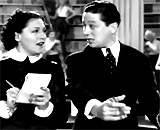 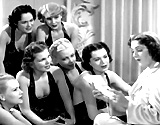 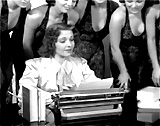 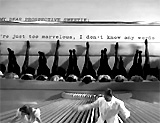 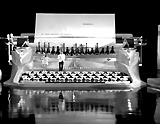 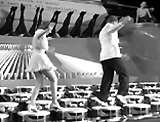
|
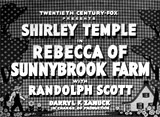
|
Rebecca of Sunnybrook Farm (1938) This 20th Century Fox musical-film by director Allan Dwan was very loosely based upon Kate Douglas Wiggin's 1903 novel "Rebecca of Sunnybrook Farm," about an orphaned young girl named Rebecca Randall. There were two previous films with the same title: in 1917 (with Mary Pickford) and in 1932 (with Marian Nixon and Ralph Bellamy), but this was the first one to incorporate music. It repeated elements (and a medley of songs, such as On The Good Ship Lollipop, Animal Crackers In My Soup, When I'm With You, Oh My Goodness, and Goodnight My Love) from earlier Shirley Temple movies. Its title character in this version was orphaned Rebecca Winstead (Shirley Temple) who lived with her Aunt Miranda Wilkins (Helen Westley) on a farm. There, she became acquainted with farmhand Aloysius (Bill "Bojangles" Robinson). In the climactic final scene, Rebecca and Aloysius wore uniforms while tap-dancing together (and ascending/descending stairs) in a military dance number, to the tune of Raymond Scott's The Toy Trumpet (pictured often). |
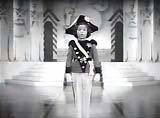  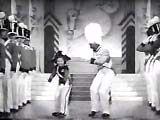
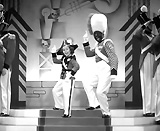 |
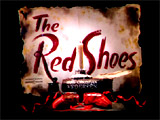
|
The Red Shoes (1948, UK) This was Emeric Pressburger and Michael Powell's stylized and Technicolored adaptation of the famous Hans Christian Andersen fairy tale - considered the quintessential ballet film (and one of the best British films of all-time), especially in its 15-20 minute balletic sequence titled The Ballet of the Red Shoes (pictured often). It was filled with beautiful, expressive, and vibrantly-photographed ballet dancing (by the exquisite Moira Shearer as aspiring ballerina Victoria "Vicky" Page), often directed by the authoritarian rule of charismatic ballet impresario Boris Lermontov (Anton Walbrook) of Ballet Lermontov. |
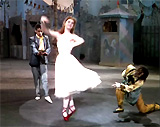 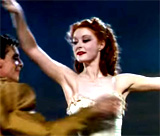  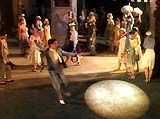
|
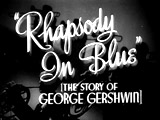
|
Rhapsody in Blue (1945) Warner Brothers' and Irving Rapper-directed fictionalized biography of the famed American composer George Gershwin (portrayed by Robert Alda in his screen debut) began the trend to produce biopics of composers/musicians. This one's title reflected Gershwin's 1924 musical composition. The musical film was nominated for two Academy Awards: Best Musical Score and Best Sound. It starred many musicians as themselves:
It also featured almost two dozen of Gershwin's tunes, including:
There were also concert performances:
|
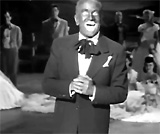 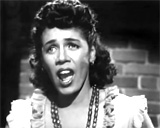 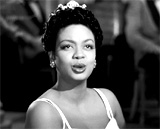 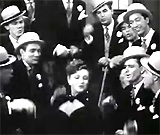  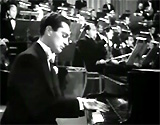 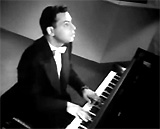
|
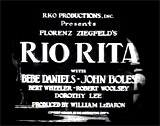 |
Rio Rita (1929) RKO's first major all-talking production, one of the first musical spectaculars (filmed in black and white with one rare Technicolor sequence in the last half hour), starred:
It was a popular but costly adaptation of Florenz Ziegfeld's successful 1927 Broadway stage musical hit that was filmed virtually as a faithful transcription of the play. A few of its more memorable numbers were:
It was later remade in 1942 by MGM as a Bud Abbott and Lou Costello vehicle and musical comedy, with Kathryn Grayson as Rita. |
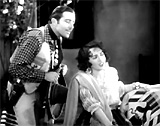 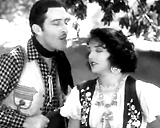 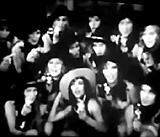 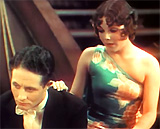
|
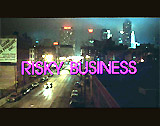
|
Risky Business (1983)
This R-rated, satirical teen romantic-comedy from first-time writer and director Paul Brickman was famed for one musical scene:
|

|
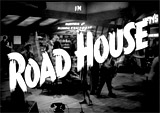
|
Road House (1948) In this dramatic, action-filled film-noir from director Jean Negulesco (his fifth and last noir), jealous, sociopathic nightclub owner Jefty Robbins (Richard Widmark) became infatuated with his own racy torch singer Lily Stevens (Ida Lupino). He had hired her for six weeks as a 'new entertainer from Chicago' for his rural, north Midwestern roadhouse (with a bar and bowling alley) near the Canadian border, paying her a higher salary than normal - he was also hoping to become more personally involved with her. She delivered her debut number - a sexy, low-throated, gravel-voiced hot rendition of Johnny Mercer's One For My Baby (And One More For the Road) (pictured), accompanying herself at the piano in the lounge. [Note: The song was originally sung and danced by Fred Astaire in the romantic-comedy musical The Sky's the Limit (1943).] The club's cashier Susie Smith (Celeste Holm) commented afterwards: "She does more without a voice than anybody I've ever heard." The tale evolved into a vengeful love-triangle plot, when Lily fell for Jefty's life-long friend and handsome business manager Pete Morgan (Cornel Wilde) rather than for Jefty. |
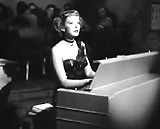  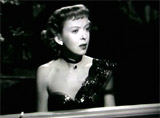 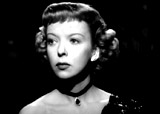
|
(alphabetical by film title) Introduction | A-1 | A-2 | B-1 | B-2 | B-3 | C-1 | C-2 | D-1 | D-2 | E | F-1 | F-2 | G-1 | G-2 H-1 | H-2 | I-J | K | L-1 | L-2 | M-1 | M-2 | N-O | P-1 | P-2 | R-1 | R-2 | S-1 | S-2 | S-3 | T | U-V | W | X-Z |